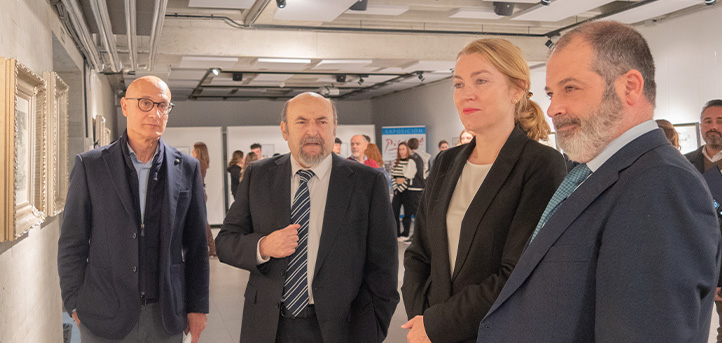In commemoration of the 50th anniversary of the death of Pablo Picasso, one of the most outstanding artists of the 20th Century, and in celebration of the 10th Anniversary of the Universidad Europea del Atlántico (European University of the Atlantic, UNEATLANTICO), the exhibition hall of the university has joined both tributes with the opening of an exhibition dedicated to the work of Pablo Picasso.
The exhibition, consisting of three outstanding collections by the artist —La Flauta doble (The Double Flute), La Tauromaquia (Bullfighting), and Bocetos para Guernica (Sketches for Guernica)— was inaugurated this Thursday with the presence of the Minister of Culture, Tourism, and Sports of the Government of Cantabria, Eva Guillermina Fernández. The event was also attended by the General Director of Cultura (Culture), José Antonio González Fuentes. On behalf of the University, the following spoke: the rector of UNEATLANTICO, Rubén Calderón, and the Dean of the Faculty of Social Sciences and Humanities, Federico Fernández.
The Minister of Culture, Eva Guillermina Fernández, stressed that “this is a unique opportunity for the inhabitants of Santander, the people of Cantabria, and those who wish to visit, to enjoy unique works that are not easily accessible and that are part of this magnificent collection that we have the opportunity to appreciate at the university.”
Referring to UNEATLANTICO, the Minister emphasized that “in these ten years of existence, the university has not only played a fundamental role in energizing the educational life of Santander by attracting students from Spain and other nationalities but has also contributed significantly to enriching cultural life.” She also extended her congratulations to those responsible for a decade of “very fruitful” work.
The collections
In relation to the exhibition, Eva Guillermina Fernández pointed out that “it gives us the opportunity to immerse ourselves in the Picasso universe through three extraordinary collections.” She also stressed that “these works reveal Picasso’s mastery in the handling of shadows and reliefs, providing us with a very personal and intimate testimony of his artistic trajectory.”
“To contemplate this work is to immerse oneself in 30 years of Picasso’s life. Here we find works ranging from 1930 to 1957, including paintings, drawings, and engravings,” remarked Federico Fernandez, who guided those present through the various collections.
Likewise, Federico Fernández pointed out that FUNIBER, the promoter of UNEATLANTICO, has ten series of Picasso exhibited in different countries. Likewise, he emphasized that the exhibition of La Flauta doble itself is presented after having been exhibited for years in various places in America.
Referring to La Flauta doble, he pointed out that this compilation covers the period between 1930 and 1955. In that year, the portraits of Jaqueline Roque, the artist’s last wife, and at the beginning of the series, La Flauta doble, which takes its name alluding to the god Pan, stood out. “It is important to note that there is an academic, neoclassical style but always transformed by his way of working,” he stressed.
In the gallery’s chapel are the Bocetos para Guernica, created “in 1937, commissioned by the French government for the Paris International Exposition of that year,” he explained. “Picasso drew considerably on May 3. He transforms the woman into the protagonist, works intensely on the horse, which also symbolizes the woman, and the minotaur, the man, twisting it as an expressionist manifestation of the pain caused by the effects of war. It is a perennial plea against war,” Fernandez emphasized.
Finally, Federico Fernández pointed out that La Tauromaquia, commissioned by Gustavo Gili, is “the most valuable” of the collections present, indicating that there are only ten editions like this one in the world made on Japanese paper. “The collection is made up of aquatints that the painter made to illustrate the bullfighting of Pepe Hillo,” said the Dean.
Finally, with respect to La Tauromaquia, commissioned by Gustavo Gili, Federico Fernández emphasized that it is “the most valuable” of the collections present, pointing out that there are only ten editions like this one in the world, produced on Japanese paper. “The collection is composed of aquatints that the painter made to illustrate the bullfighting of Pepe Hillo,” he said.


